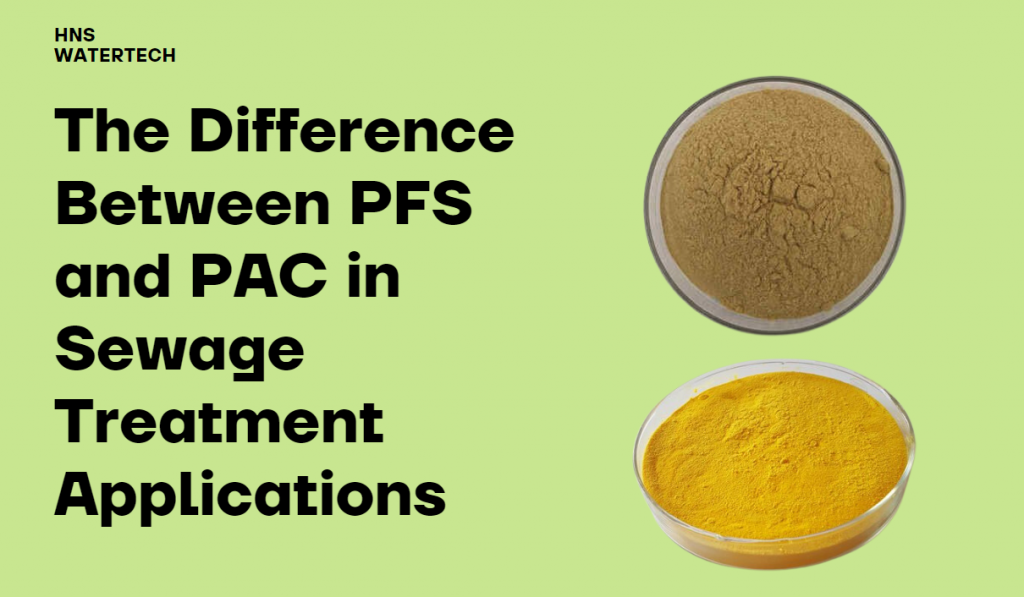The Difference Between PFS and PAC in Sewage Treatment Applications

Introduction
When it comes to sewage treatment applications, two commonly used chemicals are Polyferric Sulfate (PFS) and Powdered Activated Carbon (PAC). While both serve the purpose of treating wastewater, they have distinct differences in their composition, mode of action, and effectiveness. In this article, we will explore these differences and help you understand which chemical is best suited for your sewage treatment needs.
1. Polyferric Sulfate (PFS)
1.1 Composition and Properties
PFS is a coagulant that is widely used in sewage treatment plants. It is composed of a mixture of iron salts, primarily ferric sulfate, and polymeric compounds. The unique combination of these components allows PFS to effectively remove suspended solids, organic matter, and phosphorus from wastewater.
1.2 Mode of Action
When PFS is added to wastewater, it undergoes hydrolysis, forming positively charged iron hydroxide flocs. These flocs attract and neutralize negatively charged particles in the wastewater, causing them to clump together and settle. This process, known as coagulation, helps in the removal of pollutants and improves the clarity of the treated water.
1.3 Advantages of PFS
- PFS has a high coagulation efficiency, leading to improved wastewater treatment performance.
- It has a wide pH range of effectiveness, making it suitable for various sewage treatment applications.
- PFS is effective in removing both suspended solids and phosphorus, reducing the risk of eutrophication in receiving water bodies.
2. Powdered Activated Carbon (PAC)
2.1 Composition and Properties
PAC is a fine black powder made from carbonaceous materials, such as coal, wood, or coconut shells. It has a large surface area and a high adsorption capacity, which makes it an excellent adsorbent for organic compounds and certain pollutants present in wastewater.
2.2 Mode of Action
When PAC is added to wastewater, it adsorbs organic compounds onto its surface through a process called adsorption. This helps in the removal of contaminants like pesticides, pharmaceuticals, and industrial chemicals from the wastewater. PAC can also remove taste and odor-causing compounds, improving the overall quality of the treated water.
2.3 Advantages of PAC
- PAC is highly effective in removing a wide range of organic pollutants from wastewater.
- It can improve the taste and odor of the treated water, making it more suitable for reuse or discharge.
- PAC can be easily regenerated and reused, reducing operational costs in the long run.
3. Choosing the Right Chemical for Sewage Treatment
When deciding between PFS and PAC for sewage treatment applications, several factors need to be considered. These include the specific contaminants present in the wastewater, the desired treatment goals, and the operational constraints of the treatment plant. Consulting with a wastewater treatment expert is recommended to determine the most suitable chemical for your specific needs.
FAQs (Frequently Asked Questions)
Q1: Can PFS and PAC be used together in sewage treatment?
A1: Yes, PFS and PAC can be used together in sewage treatment. The combination of these chemicals can enhance the overall treatment efficiency by targeting different types of pollutants.
Q2: Are PFS and PAC safe for the environment?
A2: Both PFS and PAC are considered safe for the environment when used in recommended dosages. However, proper handling and disposal practices should be followed to minimize any potential environmental impact.
Q3: How long does it take for PFS and PAC to treat wastewater?
A3: The treatment time can vary depending on the specific conditions and the desired level of treatment. Generally, the coagulation process with PFS occurs rapidly, while the adsorption process with PAC may require a longer contact time.
Q4: Can PFS and PAC be used in drinking water treatment?
A4: Yes, PFS and PAC can be used in drinking water treatment. However, strict regulations and guidelines must be followed to ensure the safety and quality of the treated water.
Q5: What are the cost implications of using PFS and PAC in sewage treatment?
A5: The cost of using PFS and PAC in sewage treatment can vary depending on factors such as the required dosage, the volume of wastewater treated, and the availability of the chemicals. It is advisable to conduct a cost-benefit analysis to determine the most economical option for your specific application.
Conclusion
In conclusion, PFS and PAC are two commonly used chemicals in sewage treatment applications. While PFS is effective in coagulating suspended solids and removing phosphorus, PAC excels in adsorbing organic compounds and improving taste and odor. The choice between PFS and PAC depends on the specific treatment goals and the characteristics of the wastewater. By understanding the differences between these chemicals, you can make an informed decision and optimize your sewage treatment process for better water quality and environmental sustainability.
